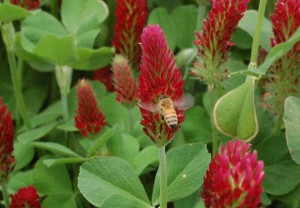When it comes to a manure application on your cover crop, be creative. There are more options than you think.
Cover crop use often goes hand in hand with manure application.

Manure nutrients can be captured quite well, preserved and recycled when applied on a living cover crop, especially in a no-till scenario. The growing roots of the cover crop will take up manure nutrients, and in the case of a liquid manure or slurry application, it’s possible to get some foliar feeding effect by the slurry application to the cover crops above ground biomass as well. Cover crops help reduce nutrient leaching, and the roots create channels, facilitating water permeation. The growing root exudates also promote soil aggregation, which helps stabilize the soil and creates pore spaces which hold both air and water. Cover crop root exudates also feed soil microbes with carbohydrates, which influence the growing root zone known as the “rhizosphere”. In this zone soil microbes actively cycle nutrients and break down organic matter compounds, liberating or “mineralizing” nutrients in the soil. The cover crop’s above ground crowns and biomass helps to hold soil in place and creates a physical barrier to slow the runoff of water across the soil surface in heavy downpour events.
By preserving/recycling the nutrients in manure in the crop root growing zone, you can create a significant cost savings in applied N, P, and K. Legume cover crops utilize the available phosphorous and potassium from the manure to grow prolifically, and available soil nitrates are used by legume roots in addition to the widely-recognized nitrogen fixation by the nodules on legume roots.
A less-common meeting of cover crop and manure
Applying manure in the spring on an actively growing cover crop is one of the less talked-about pairings of cover crops and manure. Timing will be the game-changer here, especially in a no-till situation.
Nutrients in the manure soak into the crop material and the ground gradually, setting you up for a gradual, season-long mineralization of the organic nitrogen compounds into a plant-available form. We’ve applied manure to standing cover crops near termination, spraying to kill them before the manure application. We have also applied the manure at an earlier stage of growth to the living cover crop, spraying to kill the cover at a later date; we prefer the latter. The earlier application of manure will give some time for the cover crop to assimilate the manure and grow out of the application of the manure, before it is sprayed and killed later. You can then no-till into the green cover crop and then spray to kill, an option that is becoming more common among no-tillers. Or you can apply the herbicide first to the cover crop and no-till plant into the previously sprayed cover crop. If you are going to apply manure to a later stage cover crop that is fully grown, it’s best to spray the cover crop first before applying manure to the field.
The heavy liquid or semi-solid manure application may extend the weed control abilities of the living cover crop. Once the manure dries, the result may be a plaster-like layer that acts as an almost total barrier against weed growth. The residue from the cover crop (which can be pretty thick if you do this at bloom or heading stage of the cover crop) meshes with the manure to form a rugged mat. Once the following crop is planted, the thick, fibrous mat continues to suppress weeds as the material breaks down.
Case study: Crimson clover before corn
If you’ve planted a legume, you’ll get a double shot of nitrogen with the addition of the manure coating. In our research plots last year, we planted crimson clover in the fall of 2013 and then the following spring killed it with glyphosate and plastered the crop with a semi-solid manure slurry. The no-till corn planting that followed was challenging in terms of cutting through this thick, crusty mulch layer and getting the proper seed-to-soil contact, but after planting, we had good season-long weed control and high silage and grain yields (these plots were sampled for both silage and grain, with relative maturities of the 21 hybrids ranging from 90-117 days) The great majority of these were conventional (non-traited) or organic hybrids. Yields were impressive, with average silage yield reaching 12 tons of dry matter, and grain yields averaging 243 bu/A – and no additional fertilizer nitrogen was applied to these corn crops. The corn crops stayed green throughout the season, and didn’t run out of nitrogen with the combined release of nitrogen from the cover crops, applied manure and also from the soil organic matter, despite heavier than usual precipitation throughout the season.
It should be noted that 2014 saw exceptional corn yields overall in the Northeast – weather was cooler and moister than average, which helped growth, grain fill, and grain test weight. These yields also took place on a farm that practices continuous no-till in diverse double- and triple-crop rotations, and has built its organic matter by several percentage points over the years with this sound management. All of these factors contribute to high yields, but this cover cropping practice was certainly a major contributor last year, replacing starter fertilizer application and side-dressing with a season-long slow-release of nutrients that coincided well with the corn’s growth.
Some modifications
This year we’re trying a modification to that process. The fall-planted cover crop before the corn plots is a mix of hairy vetch, oats, and crimson clover. There is residue from the winter-killed oats, along with thriving vetch and clover (both winter annual legumes, with the crimson clover typically blooming mid-May and the hairy vetch blooming late May/early June in this area). This time, we switched the manure application to early spring, just after greenup. It suppressed the cover crop growth a little, but as the cover had not been killed yet it continued to grow through the manure layer, uptaking some of the nutrients. With the recent hard thunderstorms giving us an inch of rain, this manure has been washed off the cover crop and some of it into the top soil layer. With the increased daily heat units, moisture and manure nutrients the legume cover crops will take off now.
The tradeoff is that we hamper the growth of the cover crop by driving over it and covering much of the leaf surface with manure, so some growth and nitrogen fixation is set back by wheel traffic weight. The amount of growth you end up with does also depend on the fall planting date and the warmth and moisture of the fall growing conditions, as well as winter conditions and the winter survivability of the crop.
Using a mix instead of a straight stand also varies the plant growth structure. The upright-growing crimson clover may be more affected by the manure application than the more lateral surface growth of the viney hairy vetch. Hairy vetch is a vining legume cover crop and will grow biomass from adjacent areas back over the areas that were compressed by wheel traffic. This vining growth habit spreads the above ground biomass across the soil surface to distribute viney stems and their associated nitrogen-rich leaflets across the soil surface.
In both scenarios, we are using the cover crop to retain and absorb the applied nutrients, both through physical catchment and plant uptake – but with different timing. In the latter case, though, no-till planting following the cover crop will be much less of a challenge, especially if we “plant green” – just after the burndown of the cover crop. The manure has broken down a bit and gotten washed in, no longer draping the plants in a hardened barrier.
Timing in the first scenario can contribute to a challenging no-till planting– if you have time, wait a bit for the crimson clover to break down completely under the layer of manure. When it’s in that in-between stage – no longer green but not yet dry and crunchy – it becomes a little rubbery and tough, and this will be more difficult to cut through. Either fresh or more fully decomposed makes for better planting as far as the crop residue component is concerned.
Speak to an expert at King’s AgriSeeds now at 1-717-687-6224 or email us at [email protected].

1 Comment. Leave new
[…] and no-till planting into the cover crop – which we attempted last year and wrote about here. That approach was excellent for season-long nitrogen release and weed suppression, but made […]